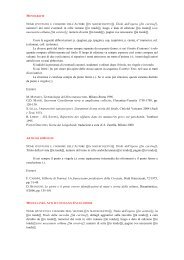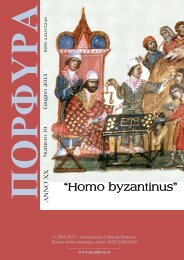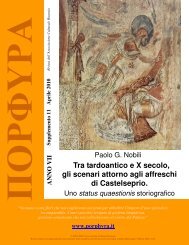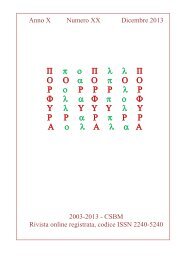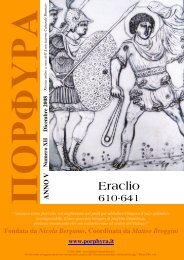ΠΟΡΦΥΡΑ - Porphyra
ΠΟΡΦΥΡΑ - Porphyra
ΠΟΡΦΥΡΑ - Porphyra
Create successful ePaper yourself
Turn your PDF publications into a flip-book with our unique Google optimized e-Paper software.
A Prôtospatharios, Magistros, and Strategos Autokrator of 11 th cent.<br />
the equipment of Georgios Maniakes and his army according to the Skylitzes Matritensis miniatures<br />
and other artistic sources of the middle Byzantine period.<br />
the style of the enamel in comparison with similar artworks 203<br />
and the scheme of the composition could not exclude a mid 11 th<br />
century date. The treatment of the suffering body of Our Lord<br />
prevents could be attributed to an earlier period, as opposed to<br />
the later date proposed by Schlumberger.<br />
Here, the Roman Centurio Longinus is represented<br />
dressed in an senior East Roman Guardsman’s dress of the 11 th<br />
cent., highly decorated and fully armoured. The device of the<br />
shield of the warrior, as well as his northern aspect and some<br />
parts of his dress, suggest to me that we should follow the<br />
interpretations of other authors who identify him as a Varangian<br />
Officer in senior uniform 204 . Of course the attribution to Harald<br />
Haardrada of this uniform is purely hypothetical, but we can<br />
suppose in any case that a Varangian Officer would wear this<br />
kind of dress and armour also on campaign, obviously with the<br />
necessary ammendments due to the use of such equipment in the<br />
field. In some sources it is said that Harald wore East-Roman<br />
armour, called Emma ; but this armour, which protected him<br />
down to the calves, should be a mail coat, even though made in<br />
Byzantium 205 . This is important as well, because it shows us that<br />
Varangians were equipped with East-Roman armoury, so that<br />
their commanders would have looked sometimes as Roman<br />
Officers in their peculiar military garb.<br />
The helmet (κασ(σ)ιδιον, κασσιs,) 206 is missing in the<br />
reliquary image, but we have reconstructed it (plate 1B) as a<br />
segmented spangen-helm 207 with reinforcing bossed plates; is of<br />
the type of the directly riveted frameless spangen-helm, a form<br />
of helmet - beside the conical one piece - shown in the artistic<br />
source of the middle Byzantine period as in dotation to the East-<br />
Roman warriors 208 . The helmet is conical-shaped, slightly<br />
203 Cfr. Bank, Byzantine art, figg. 186-189 pp. 364-365, Reliquary of the True Cross.<br />
204 See Heath, Byzantine Armies, cit., p. 26.<br />
205 Blondal, The Varangians, p. 184 and note1.<br />
206 The word, from the latin cassis, is the typical one, even if not the sole, used to design the helmet in 10-11 th Greek<br />
Medieval sources: see Leo Taktika, VI, 2; Nikephoros Praecepta militaria,III,34; Pseudo-Konstantinos-Nikephoros<br />
Ouranos Taktika, p. 4; see also Kolias, Waffen, pp. 75-77.<br />
207 The segmented helm was introduced in the Roman Army from the end of first century under the influence of<br />
Sarmatians and Dacians, as well by its use by Eastern Auxiliaries; it was composed of laminated plates converging to<br />
an apex closed by a band-rim on the top and on the edge; see James S., Evidence from Dura Europos for the origins of<br />
Late Roman helmets, in Doura Europos Studies, Geuthner 1986 pp. 113-117; its general use both for Cavalry and<br />
infantry is already attested on the Arch of Galerius in Thessaloniki, also if its widespread use is well attested in the<br />
army of the Justinian Age, where beautiful Roman specimens have been found in Frankish and Alamann graves, as<br />
well on the battlefields of western and Eastern Europe - see Die Franken, Wegbereiters Europas, Mainz 1996, pp. 262-<br />
263 fig. 193 and p. 303 fig. 243 ; Musée du Louvre, Byzance, L’art byzantin dans les collections publiques françaises,<br />
Paris 1992-1993 pp.124-125 fig. 74 ; helmet of 615 AD coming from the Roman Fortress of Heraclea Lyncestis,<br />
decorated with the image of Christ and apostles, s. Werner J., Nuovi dati sull’origine degli spangenhelme<br />
altomedioevali del tipo Baldenheim, in XXXVI corso di cultura sull’arte ravennate e bizantina, Ravenna, 1989, pp.<br />
419-430 fig. 2.<br />
208 Nicolle D., Byzantine and Islamic arms and armours, evidence for mutual influence, in Graeco-Arabica, IV, Athens,<br />
1991, pp. 299-325, p. 308-309. Beautiful specimens of 8 th cent., may be of East-Roman origin, have been found in<br />
Bohemia : cfr. Hejdova D., Early medieval helmets, in Sbornik Narodniho Muzea V Praze, XVII, 1964, pp. 41-91 and<br />
pls. XI-XII (for the find of this precious article and for very beautiful photos of the originals I must express my deep<br />
gratitude to the Dr.Evzenie Snaidrova of the National Museum in Praha); an archaeological specimen may from<br />
34



